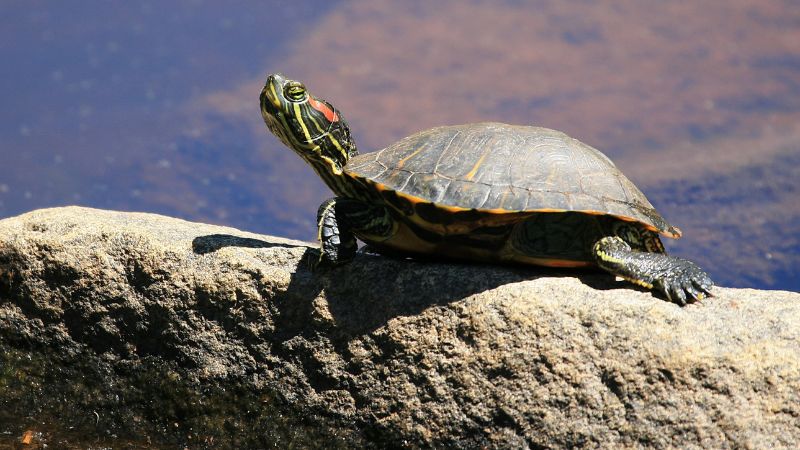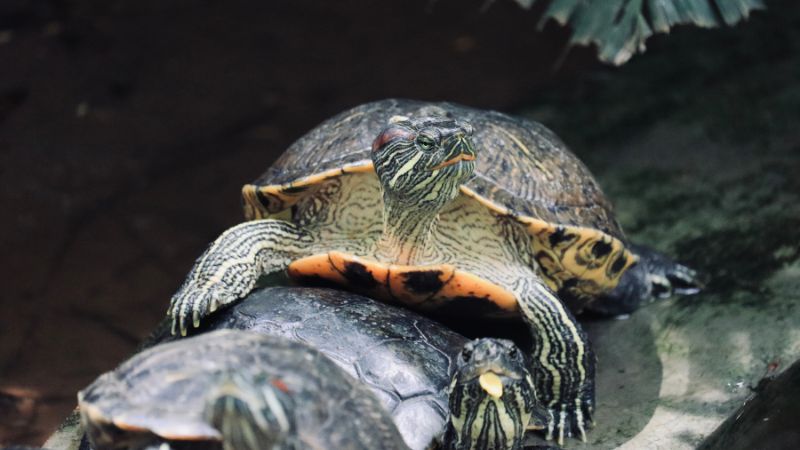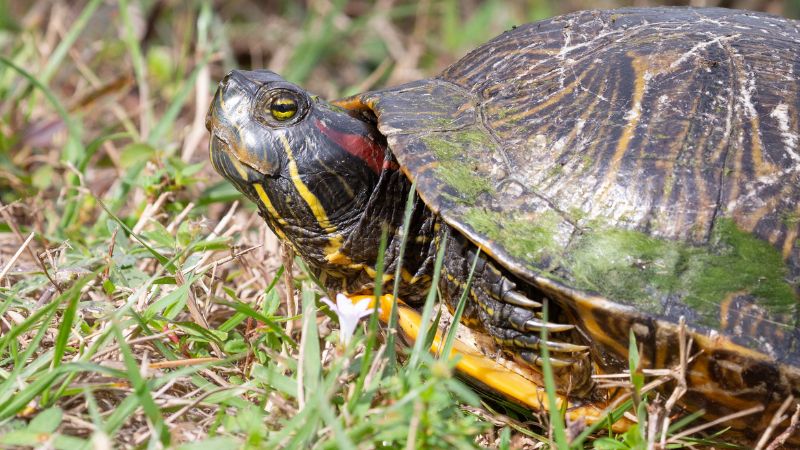Red-eared sliders may seem like the harmless, aquarium pet turtles everyone can love and take care of but they can actually cause a lot of ecological problems and health hazards.
So, how to get rid of red-eared sliders? This involves setting up traps to catch the turtles, contacting wildlife authorities to handle them, encouraging owners to rehome unwanted slider turtles, and educating the public.
For more information about red-eared sliders, how to properly identify them, what to do to get rid of them, and how to prevent them from ever coming back, read further this article!
What Are Red-Eared Sliders?

Red-eared sliders (Trachemys scripta elegans) are freshwater turtles widely kept as aquarium pets across the United States. Their names refer to the red stripe found behind each of their eyes.
These medium-sized turtles are characterized by their olive to brown skin with yellow spots or stripes and shells that are yellow or dark green with off-white or black stripes.
What Do Red-Eared Sliders Like?
Red-eared sliders love basking. In fact, they require a certain amount of sunlight to properly function. They’re more active on sunny days and during warmer months. Aside from this, they spend their time grazing, walking, foraging, and swimming.
What Do Red-Eared Sliders Eat?
They consume a variety of insects (e.g. grasshoppers, beetles) and aquatic animals such as fish, tadpoles, clams, slugs, snails, freshwater sponges, and other small reptiles. They also feed on plant material.
Where Do Red-Eared Sliders Live?
Red-eared sliders are native to south-central United States but are well-established outside their range. They are semi-aquatic animals that live in both freshwater and brackish water habitats such as swamps, ponds, rivers, lagoons, and lakes.
They can also be found on land, particularly those with water sources in close proximity, such as in savannas and semi-evergreen forests.
Related: How to Get Rid of Alligators | Safety Measures and Removal Methods
How Long Does Red-Eared Sliders Live?
Red-eared sliders are known for their long lifespans. They live up to 30 years in the wild and up to 41 years in captivity. However, it is believed that they can survive up to 75 years.
How Big Will Red-Eared Sliders Get?
Adult red-eared sliders can reach up to 12 inches in length and 3.2 kilograms in weight. This species exhibits sexual dimorphism, which means females are usually larger than males.
What Is the Behavior of Red-Eared Sliders?
Red-eared sliders are diurnal and social creatures, often found congregating in large numbers. They are both excellent swimmers and efficient at walking on dry land.
They are active from March to November, with a breeding season that typically begins from late May to early June. Their means of communication include eye rolling, touch, vibrations, and displays.
Related: How to Get Rid of Spiny Softshell Turtles | Effective and Humane Solutions
How Dangerous Are Red-Eared Sliders?

Although red-eared sliders are not known for their aggressive or territorial behaviors, they pose a threat to the health of humans and native wildlife as they are known to carry harmful bacteria such as Salmonella.
Since they reproduce and defecate in bodies of freshwater, they can pollute them and spread disease easily. In fact, the Food and Drug Administration had to place bans on the selling of these turtles under 4 inches due to potential Salmonella outbreaks.
Related: Are Opossum Feces Dangerous and Toxic to Humans and Pets? | Information and Facts
Why Are Red-Eared Sliders a Pest?
As mentioned earlier, they are a health hazard not only to humans but to pets and native wildlife as well. Females are also prolific egg-layers, which explains their steadily increasing populations even in areas they were only introduced to.
Signs of Red-Eared Sliders
If you own or know of any nearby ponds, check to see if they’re cloudier or dirtier than usual. This might mean that red-eared sliders have defecated into the water. You may also check your lawns or gardens for any signs of turtle eggs that may have been laid by female red-eared sliders.
Related: Signs of Rats | All You Need to Know
Why Are Red-Eared Sliders Increasing In Nature?

Red-eared sliders have a larger clutch size compared to other pond turtle species. They are able to produce up to 25 eggs per clutch, with up to 4 clutches a year. Thus, it comes as no surprise that they are able to spread rapidly.
Why You Shouldn’t Release Red-Eared Sliders Into the Wild?
This is because it’s exactly how they were introduced and have proliferated outside of their native range. Owners usually release them into the wild when turtles grow larger in size, making maintenance and taking care of them difficult.
Additionally, this practice is illegal in many states in the United States due to the adverse effects this may cause not only to humans but also to native wildlife. Red-eared sliders are competitive for food, shelter, and nesting sites.
Related: How to Get Rid of Snapping Turtles | Essential Strategies!
How to Get Rid of Red-Eared Sliders?
Here are some ways you can get rid of red-eared sliders while also helping the local community:
- Set up traps. Use hoop nets or box traps with bait to lure in the turtles. Once caught, make sure to contact local wildlife authorities to get rid of them efficiently. They must, at all costs, not go back into the wild.
1KOMBIUDA 2pcs 17x10inch Collapsible Fishing Cage Fine Mesh Versatile Turtle Trap for Kayak
- Baits for-- constructed from and materials, this product keeps...
- Fishing net for minnow fish shrimp crawfish crab-- equipped with...
- Collapsible fish keeping net-- its versatile design allows you to...
- Shrimp net trap-- this innovative design allows for easy folding,...
- Folding landing nets-- the tight mesh construction is...
2Frabill Flat-Bottom Crawfish Trap | Low-Profile Square Trap Specifically Designed for Crawfish- Frabill | Trusted By Anglers Since 1938
- Low-profile square shape covers large trapping area
- Adjustable entry size (check local regulations for restrictions)
- Hinged back door for easy baiting and catch removal
Sale 3Kensizer Humane Rat Trap, Chipmunk Rodent Trap That Work for Indoor and Outdoor Small Animal - Mouse Voles Hamsters Live Cage Catch and Release 1-Pack- Humane Rat Rodent Trap - After catching them, you can release...
- Light Weight Galvanized Steel - Long-lasting and sturdy, the...
- High sensitive trigger mechanism - Once the trigger is touched,...
- Exclusive Patented Design - Innovative, efficient and easy to...
- Premium Customer Service - If it's damaged in half a year, please...
- Encourage owners to rehome unwanted turtles. Instead of letting the slider turtles go once the original owners can no longer take care of them, it’s better to find a new, responsible owner who can.
- Educate the public. Help spread awareness on the dangers and invasiveness of red-eared sliders and why reporting sightings should become a top priority.
Related: How to Get Rid of Turtles | Proven Long-Term Solutions!
How to Prevent Red-Eared Sliders From Getting Into Your House?

Constructing drift fences that are securely buried 6 to 8 inches underground can prevent red-eared sliders from entering your property. Additionally, remove food sources to make the premises look less appealing to them can also help.
Related: How to Keep Frogs Away From Your House? | Information and Control Guide
List of Sources
Armentrout, K., & McGregor, C. (n.d.). Trachemys scripta: Pond Slider, scripta.
Jugmohan, K. (2015). Trachemys scripta (Red-eared Slider).
Pennsylvania State University. (2013). Red-eared Slider.
Pennsylvania State University. (2021). Removing the Invasive Red-eared Slider from Presque Isle State Park.
Redinger, J., & Sturtevant, R. (2023). Troublesome turtles: Invasive red-eared sliders in the Great Lakes.
University of Nebraska-Lincoln. (n.d.). Red-eared Slider.
Viola, J. (2016). Red-Eared Slider.
- How to Get Rid of Turtles | Proven Long-Term Solutions! - August 26, 2023
- How to Get Rid of Kingsnakes | Easy & Humane! - August 26, 2023
- How to Get Rid of Northern Water Snakes | Best Solutions and Preventative Measures! - August 19, 2023



